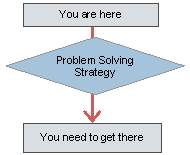|
How to Solve Physics Problems
What is problem-solving?

General Problem-Solving Strategy
Step 1: Identify what’s being given
Step 2: Clarify what’s being asked.
If necessary, rephrase the question
Step 3: Select a strategy
Trial & error, search, deductive reasoning, knowledge-based, working backwards
Step 4: Solve using the strategy
Step 5: Review the answer
Example:
Determine the relationship between force of friction and the coefficient of friction
Step |
Description |
Information |
1 |
Identify what’s given |
Force of friction and coefficient of friction |
2 |
Identify what’s asked |
How they relate |
3 |
Strategy: Deductive reasoning |
Force of friction is found with the equation: Ff = mFN
m is the coefficient of friction and is a measure of the roughness of the two surfaces. |
4 |
Apply the strategy |
As roughness increases, there is more friction.
If m is the measure of the roughness of the surfaces, then as the roughness increases the m increases.
m and friction are directly related. |
5 |
Review the solution |
The mathematic formula matches the reasoning. |
Using symbols with mneumonics:
- When writing symbols in physics, use a mneumonic to help you remember what the symbol is representing.
-
- e.g. For mass of proton, use “mp” and for velocity of car and truck use “Vc” and “Vt” rather than “V1” and “V2”
KUDOS Method
Use the KUDOS method for solving word problems.
- K = Known
- U = Unknown
- D = Definition
- O = Output
- S = Substantiation
Tips for KUDOS steps
- K (Known)
Use units to indetify information
Write information symbolically
Look for implied information
Write out chemical equations
- U (Unknown)
What is the problem looking for?
Write information symbolically
- D (Definition)
Find equalities to conver
Choose & Re-arrange equations
Look for missing information in other places
If you cannot find enough information, re-evaluate your plan
- O (Output)
Plug in values to the equations (use constants as needed)
Check unit cancellation & perform the calculation
- S (Substantiation)
Check validity of your answer
Check units
Check signficiant figures
- Example:
- What is the change in velocity if the initial velocity is 23 m/s and the final velocity is 15 m/s?
Step |
Source Information |
Write down |
K |
Initial velocity |
V0 = 23 m/s |
Final velocity |
V1 = 15 m/s |
U |
What is the change in velocity |
DV = ? m/s |
D |
Change in equation |
DV = V1 – V0 |
O |
Output of the equation |
DV = V1 – V0
DV = 15 m/s – 23 m/s
DV = -8 m/s |
S |
Substantiation |
-8 m/s atm is reasonable for velocity
“m/s” is the pressure unit given in the problem.
0 decimal places given 0 in answer |
Exam prep tips
- Stay ahead of the game
- Make a cheat-sheet
- Know the format of the test and information that’s fair game
- Make a mock exam
- Attend the review session
- Get help early
Exam taking tips
- Arrive early and prepared
- Listen & Read instructions carefully
- Memory dump first
- Skim the test and form a plan
- Answer questions sequentially
- Apply the guessing rule
- Multiple-choice tips:
- Scan all the choices
- Avoid word confusion
- Beware of absolutes
- Essay tips:
- Understand the question
- Answer the whole question and only the question
- Watch your time
- Free-Repsonse tips:
- Show partial work
- Don’t forget units
- Don’t be fooled by blank space
|

